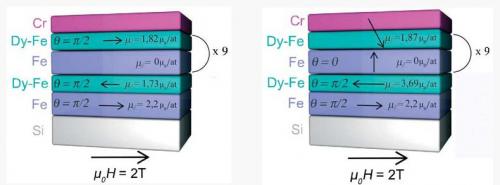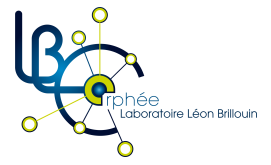Laboratoire Léon Brillouin
UMR12 CEA-CNRS, Bât. 563 CEA Saclay
91191 Gif sur Yvette Cedex, France
+33-169085241 llb-sec@cea.fr



Samples deposited at a substrate temperature of 570 K. There is some interdiffusion between the Fe and the Dy layers. (left) at room temperature, no moment was found in the Fe layer because of its amorphous nature; (right) at 100 K, the Fe and Dy-Fe layers order antiferromagnetically. The layers in contact with the substrate behave very differently from the top layers.
The magnetization of [Fe 3nm/Dy 2nm] multilayers has been studied. The samples were thermally evaporated under ultra-high vacuum at different substrate temperatures varying from 320 K to 870 K. In order to get the magnetization depth profile of these Transition Metal/Rare Earth (TM/RE) multilayers, an investigation of the structural, chemical, and magnetic properties was carried out. The samples were studied by High Resolution Transmission Electron Microscopy (HRTEM), Three-Dimensional Atom Probe (3DAP) and Polarized Neutron Reflectivity (PNR). The multilayers have been found to be rather homogeneous, except for the first two bilayers deposited on the substrate : the mainly crystalline structure of the first Fe layers leads to an enhancement of the ordering temperature of amorphous Dy. Moreover, at low temperature, a negative exchange coupling between Fe and Dy layers has been evidenced. Magnetization profiles have also been calculated by Monte Carlo simulations to support the PNR fits.
• Laboratoire Léon Brillouin (LLB) • Leon Brillouin Laboratory (LLB)

